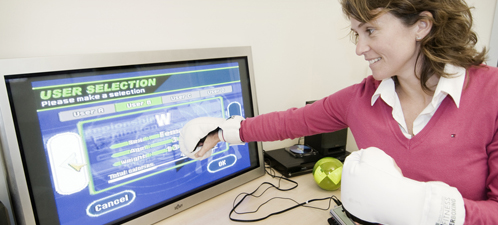
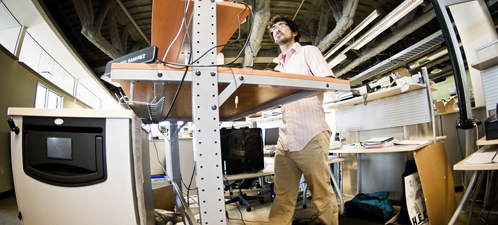
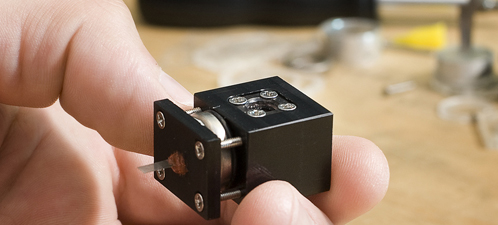
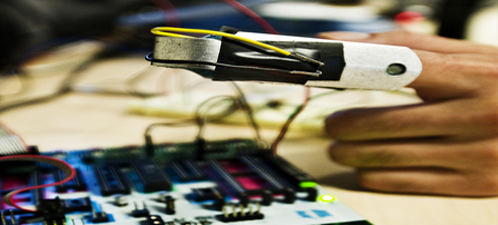
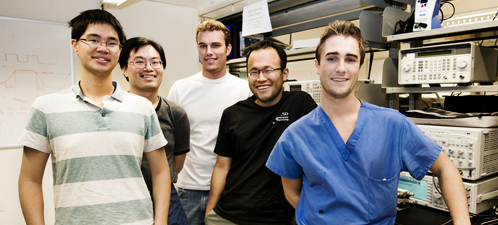
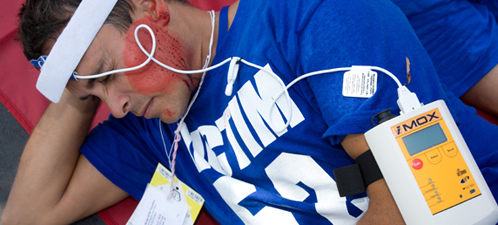
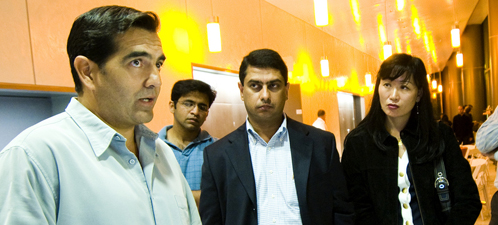
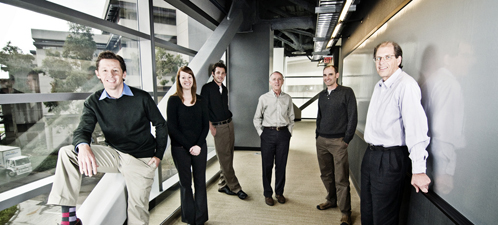
This is a draft alphabetical list of campus academic partners Calit2 is working with to realize the Institute's application vision in the health area. The list contains centers, facilities, labs and large grants, but Calit2 also works closely with many individual faculty, schools, and departments, as well as many private sector companies
Beckman Laser Institute and Medical Clinic (BLI)
BLI is a 37,000-square-foot, multi-disciplinary center for research, teaching, clinical medicine and technology transfer located on the University of California, Irvine campus. With faculty, staff and students from the Schools of Medicine, Engineering, Biological Sciences, and Physical Sciences, BLI is engaged in basic science, technology development and clinical applications using state-of-the-art biophotonic methods and devices. Two NCRR P41 Biomedical Technology Centers, the Laser Microbeam and Medical Program (LAMMP) and the Laboratory for Fluorescence Dynamics (LFD), are directed by BLI faculty. The BLI clinic has approximately 3,500 patient-visits and enrolls approximately 500 research subjects per year as one of the world's most active centers for translational technology. http://www.bli.uci.edu
Bio-Organic Nanofabrication Facility (BiON)
BiON is a 4,000-sq.-ft. clean room facility dedicated to research and development of micro-nano devices using biological and organic materials. The facility contains tools that are uniquely capable of performing micro- and nanofabrication on materials such as polymers, hydrogels, collagens, proteins and even living tissue. These materials have traditionally been difficult or impossible to micro-machine since they require special care or unusual process conditions. Many of the manufacturing techniques used in BiON have been developed as experimental processes by researchers in smaller laboratories at UC Irvine and elsewhere; these will now be available to the BiON community at large. This facility allows researchers at UCI and throughout Southern California to develop new technologies and products for environmental, life science and medical applications. The facility supports ongoing work at UCI in the areas of bio/nanotechnology, advanced materials, bio-MEMS, environmental sensors, medical devices and biological research. http://www.calit2.uci.edu/calit2-building/itemdetail.aspx?cguid=e7914cba-c83b-4a82-bba7-97bdb8e8d124
Center for Algorithmic and Systems Biology (CASB)
CASB is dedicated to the study of computational approaches in biological sciences. It serves as a worldwide bioinformatics conference center and forum for researchers in algorithmic and systems biology. CASB also promotes interactions among different departments at UC San Diego; among different institutions in the San Diego region; and between academia and industry. The center supports both original research and educational activities in bioinformatics. http://casb.ucsd.edu/
Center for Computational Mass Spectrometry (CCMS)
The computational mass spectrometry group, headed by Professors Vineet Bafna and Pavel Pevzner, and executive director Nuno Bandeira, focuses on developing algorithms to process mass spectrometry data. The lab has developed a number of tools for computational proteomics, each with its own purpose and setting. These tools are free for download, but are also integrated into a web server. http://proteomics.ucsd.edu
Center for Research in Biological Systems (CRBS)
CRBS is an organized research unit (ORU) at UC San Diego that exists to provide human resources, high technology equipment and administrative services to scientists researching cell structure-and-function relationships in central nervous system processes, cardiovascular networking and muscular contraction through multiple scales and modalities. CRBS facilitates an interdisciplinary infrastructure in which people from biology, medicine, chemistry and physics can work with those from computer science and information technologies. Researchers share interests in the study of complex biological systems at many scales, from the structures of enzymes, proteins and the body's chemical communications network at atomic and molecular levels, to an organism's physiology, strength and support at cellular and tissue levels. http://crbs.ucsd.edu/
Center for Wireless and Population Health Systems (CWPHS)
CWPHS research focuses on how the health of individuals, families, communities, social networks, and populations can be improved through the creative use of wireless and networked technologies and ubiquitous computing. The center also studies how to promote health and prevent disease and disability through systems-level interventions in clinical and community settings. Collaborators come from the UCSD School of Medicine, UCSD's Division of Social Sciences, the Jacobs School of Engineering, the San Diego Supercomputer Center and San Diego State University. Included are scientists with backgrounds in clinical and preventive medicine, computer science and engineering, social networks, political science, clinical and experimental psychology, electrical engineering, health behavior, systems science, behavioral genetics, exercise and nutrition science, public health and evolutionary biology. CWPHS is housed within the UCSD Division of Calit2. Health issues addressed in recent research have included pediatric and adult obesity and their co-morbidities, depression, improving outcomes in cancer survivors, successful aging, the use of games to promote improved health behaviors, and the dynamics of health-related states within social networks. Center research is supported through public and private sources, including the National Institutes of Health, U.S. Centers for Disease Control and Prevention, National Science Foundation, Robert Wood Johnson Foundation, American Cancer Society, and Nokia Research. http://cwphs.calit2.net
Center for Emergency Response Technologies (CERT)
CERT is an active partner with Calit2 that focuses on research within the domain of emergency response and emergency-response technologies. Founded at UC Irvine in 2007 as a result of Calit2's RESCUE project (www.itr-rescue.org), the center is an interdisciplinary (e.g., computer science, social science, engineering) research effort that brings scientists and disaster-science experts together to explore technological innovations to deliver the right information to the right people at the right time during crisis response. The goal of the center is to coordinate research in emergency response across a number of academic institutions, government agencies and private-sector organizations. CERT has strategic research partnerships that span all sectors and levels of emergency services, including fire and police departments, Department of Homeland Security, as well as companies that service those sectors. http://www.cert.ics.uci.edu
Community Cyberinfrastructure for Advanced Marine Microbial Ecology Research and Analysis (CAMERA)
With funding from the Gordon and Betty Moore Foundation, CAMERA is serving the needs of the microbial ecology research community worldwide by creating a rich, distinctive data repository and resource for bioinformatics tools that address many of the unique challenges of metagenomic analysis. CAMERA is based at UC San Diego and is a partnership with the J. Craig Venter Institute. http://camera.calit2.net/
UCSD Division of Biomedical Informatics (DBMI)
The division's goals are to (1) promote excellence in biomedical informatics research, (2) collaborate with biomedical researchers in developing new quantitative methods that enable the formulation and testing of original hypotheses, (3) train the next generation of biomedical informatics specialists, and (4) interface with engineering, mathematics, information and computer science communities, serving as a hub for quantitative scientists focused on biomedical research. In close collaboration with the UC San Diego Medical Center, academic departments and research units, as well as national and international collaborators, DBMI is developing novel methods to integrate, query, mine and interpret clinical and experimental data stemming from heterogeneous sources in a secure and privacy-preserving manner. http://dbmi.ucsd.edu
Information Theory and Applications Center (ITA)
ITA is dedicated to the study of information-theory fundamentals and their relationship to communications, computer and life sciences, finance, statistics and related disciplines. The center supports both original research and educational activities in these areas. As part of its activities, ITA organizes a yearly Information Theory and Applications Workshop that draws experts from diverse fields, including information theory, communications, networking, computer science, machine learning and statistics. The number of participants has grown steadily and the fifth annual ITA Workshop in February 2010 topped 600 attendees. http://ita.ucsd.edu/
Institute of Engineering in Medicine (IEM)
IEM was established at UC San Diego as an Organized Research Unit in July 2008 to accelerate the discoveries of novel science and technology through teamwork interfacing engineering and medicine, and to facilitate the translation of innovative technologies for improved health-care delivery to the public. The institute has more than 130 outstanding faculty from UCSD's Schools of Medicine, Skaggs School of Pharmacy & Pharmaceutical Sciences, and Jacobs School of Engineering. IEM fosters cooperation with other units on campus (including Calit2), neighboring institutions, and industry partners, with the common objective of translating creative ideas into clinical medicine and novel products that will transform patient care and improve the health and well-being of people. http://iem.ucsd.edu/
Institute for Genomics and Bioinformatics (IGB)
The mission of the IGB at UC Irvine is to promote innovation at the intersection of the life and computational sciences. This interface is leading the way in revolutionizing biology, medicine and society. IGB fosters collaborative multi-and interdisciplinary research, institutes major educational programs for computational biologist, and actively transfers research information through outreach efforts. The institute also takes pride in its innovative approaches to furthering technology transfer into widespread use, including the active incubation and development of commercially relevant research and start-ups. http://www.igb.uci.edu
Nano3
Calit2's Nano3 facility at UC San Diego provides advanced capabilities for fabrication and characterization in a state-of-the-art clean room environment. The name reflects the synergetic nature of the facility, focusing in the space on three fields of nanoscale research and development: nanoscience, nanoengineering and nanomedicine. In addition to providing essential nanofabrication capabilities for research on electronic and optoelectronic materials and devices, Nano3 facilitates the pursuit of research in emerging, interdisciplinary and rapidly growing fields such as biomedical and biochemical devices, heterogeneous integrated devices and circuits, and sensor technology. http://nano3.calit2.net/
Rady's Children Hospital, San Diego
Since 1954, Rady Children's has evolved from a 59-bed hospital treating children affected primarily by polio into a comprehensive and integrated pediatric health care system with 261 beds. Rady Children's has nearly 700 physicians and more than 1,000 nurses on staff, nearly 3,000 employees, 450 active volunteers, and more than 1,200 Auxiliary members. http://www.rchsd.org/
Susan Samueli Center for Integrative Medicine
The Susan Samueli Center for Integrative Medicine at UC Irvine is successfully advancing patient care through education, evidence-based research and clinical practice applying integrative medical therapies. The center is rapidly becoming recognized for providing "new knowledge" bridging complementary and conventional treatments - all for the singular purpose of achieving better health. http://www.sscim.uci.edu
University of California Irvine Stroke and Cerebrovascular Center
UCI Medical Center's Stroke Center was the first Stroke Center in Southern California to be certified by the Joint Commission on Accreditation of Healthcare Organizations for stroke care. http://www.strokecenter.uci.edu
UC San Diego School of Medicine, Pediatrics
The Department of Pediatrics at UC San Diego is one of the nation's premier departments devoted to improving the understanding of disease pathogenesis in order to better diagnose, treat and prevent diseases in infants and children. Research efforts include basic and clinical science in various fields spanning the whole range of maladies. Another important goal in the department is to build and foster the development of the next generation of research leaders in Pediatric Medicine. http://www-pediatrics.ucsd.edu/Pages/default.aspx
UC San Diego Superfund Research Program
The UC San Diego SRP is funded by the National Institute of Environmental Health Sciences (NIEHS). The NIEHS Superfund program supports a holistic approach to research (including research translation and outreach) for the protection of human health. This is accomplished through interdisciplinary programs that integrate biomedical research with engineering, hydrogeologic, and ecologic components within the context of unique scientific themes. The UC San Diego SRP focuses on molecular mechanisms and models of exposure with applied field work in the U.S.-Mexico border region. http://superfund.ucsd.edu
